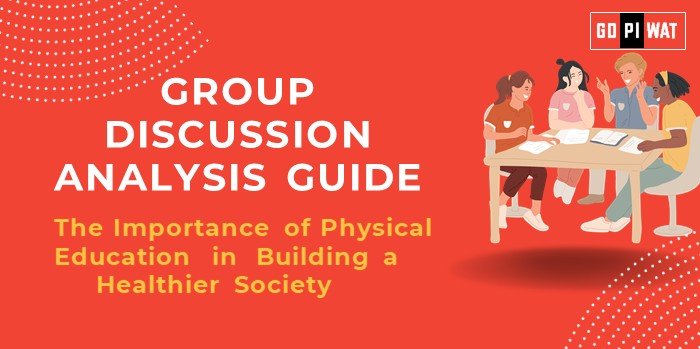📋 Group Discussion (GD) Analysis Guide
🏅 The Importance of Physical Education in Building a Healthier Society
🌟 Introduction to the Topic
- 📜 Opening Context: “In a world grappling with escalating lifestyle diseases and sedentary habits, physical education emerges as a cornerstone for societal health and well-being.”
- 📖 Topic Background: The inclusion of physical education in academic curricula has been a global initiative aimed at combating rising obesity rates, improving mental health, and promoting holistic development. India, for instance, has taken steps through programs like the Fit India Movement.
📊 Quick Facts and Key Statistics
- ⚖️ Obesity Prevalence: Over 650 million adults globally are obese (WHO, 2023) – a pressing public health issue.
- 🏃 Youth Inactivity: 81% of adolescents aged 11–17 are insufficiently physically active (UNICEF, 2023).
- 💰 Economic Impact: Physical inactivity costs the global economy $67.5 billion annually in healthcare (Lancet, 2023).
- 🇮🇳 India’s Fit India Campaign: Reached 200 million people, emphasizing physical fitness and health awareness.
🤝 Stakeholders and Their Roles
- 🏫 Educational Institutions: Incorporate PE into curricula, provide infrastructure, and promote participation.
- 🏛️ Government Bodies: Enforce policies like mandatory PE hours and initiate fitness campaigns.
- ⚕️ Healthcare Sector: Advocate for preventive health measures through exercise.
- 👨👩👧 Parents and Communities: Encourage active lifestyles among children and adolescents.
🎯 Achievements and Challenges
✨ Achievements
- 📘 Introduction of structured PE programs globally.
- 📉 Significant reduction in obesity rates in countries like Japan (10%, among the lowest worldwide).
- 📱 Integration of technology in fitness, such as wearable devices promoting activity.
⚠️ Challenges
- 🏗️ Lack of infrastructure in rural schools.
- ⚖️ Societal emphasis on academic over physical achievements.
- 🧠 Limited awareness of mental health benefits tied to exercise.
Global Comparisons:
- 🇯🇵 Japan: Mandatory PE contributes to the country’s low obesity rate.
- 🇳🇴 Scandinavia: Emphasis on outdoor physical education, promoting lifelong habits.
Case Study:
- 🌴 Kerala: School-based health initiatives include mandatory physical activities, improving both student attendance and physical health metrics.
🗣️ Structured Arguments for Discussion
- 📈 Supporting Stance: “Physical education fosters not only physical but mental and emotional well-being, reducing the burden on healthcare systems.”
- ⚖️ Opposing Stance: “With academic pressures mounting, prioritizing physical education may divert attention from critical learning outcomes.”
- 💡 Balanced Perspective: “Physical education should complement academics, not compete, fostering a holistic development model.”
💬 Effective Discussion Approaches
- 📌 Opening Approaches:
- Start with a statistic: “With lifestyle diseases accounting for 60% of global deaths, physical education becomes a critical intervention.”
- Relate to societal impact: “Physical fitness in youth directly correlates with national productivity and reduced healthcare costs.”
- 🔄 Counter-Argument Handling:
- “While academics are important, studies show that physical fitness enhances cognitive performance, benefiting academic outcomes too.”
📈 Strategic Analysis of Strengths and Weaknesses
Strengths:
- 💰 Reduces healthcare costs.
- 🧠 Improves mental health metrics.
Weaknesses:
- 🏗️ Poor funding in public schools.
- ⚖️ Cultural neglect in certain societies.
Opportunities:
- 📱 Integrate sports with technology.
- 🌍 Leverage global campaigns like WHO’s Healthy Schools initiative.
Threats:
- 📱 Rising screen time among youth.
- 📜 Insufficient government policy enforcement.
🏫 Connecting with B-School Applications
- 📚 Real-World Applications:
- Use in marketing fitness products or gym startups.
- Application in workplace wellness programs.
- 🎓 Sample Interview Questions:
- “How can physical education contribute to economic growth?”
- “What lessons can corporate wellness initiatives take from school PE programs?”
- 💡 Insights for B-School Students:
- Importance of work-life balance.
- Fitness as a leadership trait.


